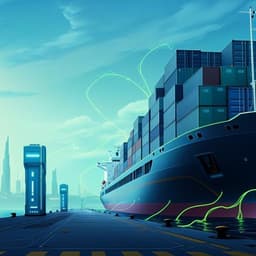
Environmental Studies and Forestry
Rapid battery cost declines accelerate the prospects of all-electric interregional container shipping
J. Kersey, N. D. Popovich, et al.
Discover the groundbreaking study by Jessica Kersey, Natalie D. Popovich, and Amol A. Phadke on battery-electric containerships. This research reveals how transitioning to electric power could cut global maritime CO₂ emissions by 14%, while making economic sense for routes up to 5,000 km. Dive into the future of sustainable shipping!
~3 min • Beginner • English
Introduction
The paper addresses whether and under what conditions direct battery-electrification of containerships can be technically feasible, cost-competitive, and environmentally beneficial relative to conventional heavy fuel oil (HFO) propulsion. The context is the shipping sector’s substantial contribution to global CO2e (≈2.5%), SOx (≈12%), and NOx (≈13%) emissions and tightening International Maritime Organization (IMO) regulations (e.g., sulfur limits and long-term GHG targets). While operators have pursued incremental efficiency measures (slow steaming, routing, hull maintenance), these deliver only 10–15% emissions reductions and are insufficient for forthcoming standards. Alternatives such as hybridization, nuclear, LNG/methanol/LPG and e-fuels face cost, regulatory, and lifecycle GHG challenges. The study posits that recent declines in battery cost and gains in energy density, together with the inherent efficiency advantage of electric drivetrains over e-fuels, warrant a rigorous reassessment of battery-electric containerships. The purpose is to quantify technical constraints (volume/weight/draught), economics (total cost of propulsion, TCP), and environmental impacts across ship classes and routes.
Literature Review
The paper reviews existing approaches to decarbonizing shipping: operational efficiencies (slow steaming, routing, hull fouling control) yield limited reductions (~10–15%). Hybrid battery systems can cut emissions modestly in some segments (≈14% for dry bulk in best cases). Small modular nuclear reactors are technically viable but face severe regulatory and public acceptance barriers. Alternative liquid/gaseous fuels (MGO, LPG, LNG, methanol and bio-derivatives) have uncertain pathways to meaningful lifecycle GHG reductions and cost parity. Hydrogen- and ammonia-based e-fuels made with renewable power can reduce operational emissions but suffer from high energy conversion losses; direct electrification is roughly five times more efficient than e-fuels in transport when excluding e-fuel transport and storage losses. Prior studies deem battery ships unfavourable due to low battery energy density and high cost, but their assumptions (energy density and $/kWh) are outdated by one to two orders of magnitude compared to current LFP performance (~210 Wh/kg, pack prices ≈US$100–134/kWh). Moreover, past work often constrained batteries to existing engine/fuel spaces rather than evaluating the opportunity cost of additional cargo space, potentially understating feasible ranges.
Methodology
The authors model eight containership size classes across 13 major global trade routes (≈911 km Shanghai–Busan to ≈20,476 km Shanghai–Santos) to estimate energy needs, emissions, and total cost of propulsion (TCP) for battery-electric versus slow-speed, two-stroke ICE ships using HFO/VLSFO. Two scenarios are defined: (1) Baseline—battery volumetric energy density 470 Wh/l, battery cost US$100/kWh, HFO cost US$0.048/kWh (≈US$538/t), electricity price US$0.035/kWh, charging infrastructure utilization 50% with levelized cost ≈US$0.029/kWh. (2) Near-future—battery cost US$50/kWh, volumetric energy density 1,200 Wh/l, charging utilization 70% (≈US$0.021/kWh), and (in figure analyses) higher HFO price (US$840/t including a US$100/tCO2e tax in some comparisons). Technical modelling: Energy demand is estimated via Admiralty Law/propeller scaling; ICE tank-to-wake efficiency 50%; motor and inverter efficiencies 95% each for electric ships. Additional displacement from battery mass is translated to draught increase via Archimedes’ principle, affecting resistance and power needs. Battery pack assumptions: packing fraction 0.76, usable depth-of-discharge 80%. Chemistry selection emphasizes LFP for near-term deployments given cycle life, charge rates, operating temp, and cost; NMC/NCA/LTO suitability is discussed by use case. The rated battery energy must cover each one-way voyage assuming charging at both origin and destination. Auxiliary loads are set at 22% of propulsion power; slow steaming and manoeuvring/hoteling energy are neglected for simplicity. Charger sizing: required MW to recharge within typical berth/queuing times (≈31–97 h depending on ship size). Infrastructure technologies include contact-based shore power and emerging inductive systems. TCP framework: For ICE ships—fuel (HFO/VLSFO), O&M, scrubber operation; for battery-electric—electricity, O&M (assumed 50% of ICE O&M excluding scrubber), levelized charging infrastructure cost, battery capital (original + replacement; LFP replacement after 5,000 cycles or 20 years), and the opportunity cost/credit of TEU capacity forfeited or freed by battery volume relative to ICE mechanical and fuel spaces (TEU volume 2.6 m × 2.4 m × 6.1 m; average loaded TEU weight 28.2 t). Newbuild capital cost of the vessel is excluded (propulsion is a small share and electric motors are cheaper than marine ICEs). Environmental costs where included: NOx US$13,000/t, SOx US$24,000/t, SCC US$43/tCO2. Emissions accounting: Tank-to-wake comparisons for ICE factors (CO2, NOx, SOx). For battery-electric, grid well-to-tank intensities from multiple countries are converted to tank-to-wake by applying transmission/distribution (5%), AC/DC (10%), DC/AC (5%), and motor (5%) losses. Battery production emissions are excluded due to high uncertainty and to maintain comparability with alternative fuels’ tank-to-wake scope. The analysis focuses on newbuilds (retrofit costs not modelled).
Key Findings
- Technical feasibility: For voyages under ~5,000 km, the increase in power due to higher draught from battery mass is typically <10%. Example: a small neo-Panamax needing ~5 GWh LFP (260 Wh/kg) for 5,000 km would add ~20,000 t, increasing draught by ~1 m—within Scantling draught. For longer ranges, draught limits are exceeded without redesign. Flexible BES placement can replace/offset ballast and fit within mechanical/void spaces.
- Cargo impact: Battery volume often fits within or modestly exceeds existing ICE and fuel spaces on short/medium routes. For a small neo-Panamax, routes <3,000 km require less volume than current ICE + tanks; at 20,000 km, batteries would occupy ~2,500 TEU (~32%). Larger ships forfeit a smaller percentage of capacity due to better carrying-capacity-to-energy ratios. Near-future energy density (1,200 Wh/l) can yield net positive carrying capacity up to ~2,000–5,000 km depending on class.
- Charging: Required charger capacities to recharge within typical port times are <300 MW for voyages <10,000 km. A ~220 MW charger can recharge a 7,650 TEU small neo-Panamax in ~24 h. Levelized charging infrastructure cost is estimated ~US$0.03/kWh at 50% utilization for a 300 MW station; ~US$0.021/kWh at 70% utilization in near-future.
- Economics (TCP, excluding environmental costs): Baseline—battery-electric achieves cost parity only for large ships (>8,000 TEU) on routes <~1,000 km. Near-future—parity around ~3,000 km for all size classes; without higher HFO prices, ~2,000 km; with HFO ≈US$0.027/kWh higher, ~3,300 km. Improvements in energy density mainly reduce TEU opportunity costs; battery price is the dominant factor. Batteries would need to fall to ~US$20/kWh for ~10,000 km nonstop transoceanic parity without recharging, which is unlikely for Li-ion but might be approached by emerging low-cost chemistries (e.g., iron-air) for long-duration storage.
- Economics (including environmental costs): Baseline—accounting for NOx, SO2, and CO2 increases the cost-effective range to ~5,000 km across size classes (given high HFO externalities vs. grid electricity). Near-future—cost-effective range extends to ~6,500 km for smaller ships and up to ~12,000 km for the largest ships; however, draught constraints limit technical feasibility at the longest ranges without design changes.
- Emissions: Battery-electric eliminates direct combustion emissions and reduces well-to-wake intensities depending on grid mix. Versus HFO/VLSFO for a small neo-Panamax: CO2 reductions are ~14–16% (US grid) and ~51–52% (UK), but could increase emissions by ~46% on very carbon-intensive grids (e.g., Saudi Arabia) absent renewables. SO2 reductions are ~86% (US) and ~4% (China) vs. VLSFO; ~97% (US) and ~77% (China) vs. HFO. NOx reductions are ~83% (US) and ~42% (China) vs. VLSFO; ~96% (US) and ~88% (China) vs. HFO. Pairing charging with renewables maximizes benefits and eliminates downstream emissions.
- Deployment potential: Over 40% of global containership traffic (intraregional and feeder routes <~5,000 km) could be electrified cost-effectively with current/near-term technology, potentially cutting CO2 emissions by ~14% for US-based vessels and markedly improving air quality in coastal communities. Feeder fleets are older and likely to be scrapped earlier under sulfur caps, creating near-term replacement opportunities for electric ships.
Discussion
Findings indicate that direct electrification can immediately decarbonize intraregional and inland container routes, outperforming e-fuels on efficiency and likely cost trajectories. With today’s battery costs (~US$100/kWh), battery-electric is competitive on short routes; policy internalizing environmental damages expands competitiveness to medium ranges (~5,000 km). Near-future battery cost reductions (~US$50/kWh) and better charging utilization substantially extend cost-effective ranges. Technical constraints (draught/weight) limit single-leg transoceanic electrification with Li-ion at current costs, but strategic logistics—hub-and-spoke operations and offshore charging at chokepoints (e.g., Suez, Malacca, Gibraltar, Panama)—can segment long voyages and enable wider adoption. Emissions benefits depend on grid carbon intensity; colocating charging with renewables (especially offshore wind near coasts where most ship traffic occurs) can unlock near-zero operational emissions and avoid local air pollutants. Electrification also offers operational advantages (lower O&M, smaller/lighter motors than ICEs) and resilience co-benefits (multi-GWh onboard storage for emergency grid support). Overall, rapid battery cost declines and infrastructure can accelerate decarbonization of a large share of global container traffic in this decade, while design innovations or alternative low-cost chemistries could eventually address longer-range segments.
Conclusion
The study demonstrates a clear, near-term pathway for battery-electric propulsion to decarbonize a large fraction of containership traffic. At ~US$100/kWh, electrification is cost-effective for many intraregional routes (<~1,000–1,500 km without externalities; up to ~5,000 km when environmental costs are included). With ~US$50/kWh batteries and improved infrastructure utilization, parity extends to ~2,000–3,300 km (excluding externalities), with even longer ranges economically favourable though potentially constrained by draught. More than 40% of global containership movements could be electrified, delivering substantial CO2 and air pollutant reductions and health benefits. Future work should: (i) analyze operational strategies and economics with intermediate/offshore recharging; (ii) extend techno-economics to other ship classes (bulk carriers, tankers, cruise), including weight-limited designs; (iii) model retrofits and financing structures for high upfront battery costs; (iv) integrate evolving battery chemistries (e.g., solid-state, iron-air) and port-renewable integration; and (v) incorporate lifecycle battery manufacturing and recycling impacts under realistic supply chains.
Limitations
- Technical constraints: For voyages >~5,000 km, battery mass can push draught beyond Scantling limits absent ship redesign; results at very long ranges are economic but may not be technically feasible with current hulls.
- Scope and assumptions: Analysis focuses on newbuilds; retrofit costs and complexities are not included. Some operational factors (manoeuvring/hoteling energy, detailed sea-state/weather effects) are neglected. Average speeds and auxiliary loads are fixed assumptions.
- Cost inputs: TCP results depend on assumed battery costs, HFO prices (including carbon pricing), electricity prices, and charging utilization; different markets may face different values. TEU opportunity costs use representative freight rates and an average loaded TEU weight.
- Emissions accounting: Battery production lifecycle emissions are excluded; only tank-to-wake comparisons are used for parity with alternative fuels’ scope. Grid intensity assumptions vary by country; benefits depend on renewable penetration.
- Environmental cost valuation: The SCC of US$43/tCO2 is conservative relative to values consistent with 1.5 °C pathways, potentially understating environmental externalities of ICE ships.
Related Publications
Explore these studies to deepen your understanding of the subject.







